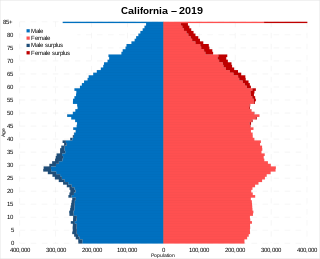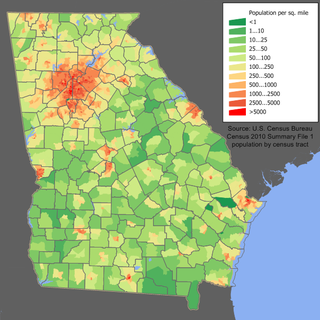The terms multiracial people refer to people who are of multiple races, and the terms multi-ethnic people refer to people who are of more than one ethnicities. A variety of terms have been used both historically and presently for multiracial people in a variety of contexts, including multiethnic, polyethnic, occasionally bi-ethnic, biracial, mixed-race, Métis, Muwallad, Melezi, Coloured, Dougla, half-caste, ʻafakasi, mulatto, mestizo, mutt, Melungeon, quadroon, octoroon, griffe, sacatra, sambo/zambo, Eurasian, hapa, hāfu, Garifuna, pardo, and Gurans. A number of these once-acceptable terms are now considered offensive, in addition to those that were initially coined for pejorative use.
The following are links to lists of United States cities in which a majority of the population is not white organized by majority racial group. The US census officially recognizes six racial categories: White American, Black or African American, Native American and Alaska Native, Asian American, Native Hawaiian and Other Pacific Islander, and people of two or more races. It should not, however, be inferred that every city not on one of the lists below has a white majority.

The demographics of Chicago show that it is a very large, and ethnically and culturally diverse metropolis. It is the third largest city and metropolitan area in the United States by population. Chicago was home to over 2.7 million people in 2020, accounting for over 25% of the population in the Chicago metropolitan area, home to approximately 9.6 million.

White Americans are Americans who identify as white people. In a more official sense, the United States Census Bureau, which collects demographic data on Americans, defines "white" as "[a] person having origins in any of the original peoples of Europe, the Middle East, or North Africa". This group constitutes the majority of the people in the United States. According to the 2020 census, 71%, or 235,411,507 people, were White alone or in combination, and 61.6%, or 204,277,273 people, were White alone. This represented a national white demographic decline from a 72.4% white alone share of the US population in 2010.
The United States has a racially and ethnically diverse population. At the federal level, race and ethnicity have been categorized separately. The most recent United States census recognized five racial categories, as well as people who belong to two or more of the racial categories. The United States also recognizes the broader notion of ethnicity. The 2000 census and 2010 American Community Survey inquired about the "ancestry" of residents, while the 2020 census allowed people to enter their "origins". The Census Bureau also classified respondents as either Hispanic or Latino, identifying as an ethnicity, which comprises the minority group in the nation.

At the 2010 census, there were 1,526,006 people, 590,071 households, and 352,272 families residing in the consolidated city-county of Philadelphia, Pennsylvania. The population density was 4,337.3 people/km2. There were 661,958 housing units at an average density of 1,891.9 units/km2.
The demographics of Brooklyn reveal a very diverse borough of New York City and a melting pot for many cultures, like the city itself. Since 2010, the population of Brooklyn was estimated by the Census Bureau to have increased 3.5% to 2,592,149 as of 2013, representing 30.8% of New York City's population, 33.5% of Long Island's population, and 13.2% of New York State's population. If the boroughs of New York City were separate cities, Brooklyn would be the third largest city in the United States after Los Angeles and Chicago.

California is the most populous U.S. state, with an estimated population of 38.9 million as of 2023. It has people from a wide variety of ethnic, racial, national, and religious backgrounds.

Caribbean Americans or West Indian Americans are Americans who trace their ancestry to the West Indies in particular or Caribbean in general. Caribbean Americans are a multi-ethnic and multi-racial group that trace their ancestry further in time to Europe, Africa, Asia, and the Indigenous peoples of the Americas. As of 2016, about 13 million — about 4% of the total U.S. population — have Caribbean ancestry.

Since its founding in 1625 by Dutch traders as New Amsterdam, New York City has been a major destination for immigrants of many nationalities who have formed ethnic enclaves, neighborhoods dominated by one ethnicity. Freed African American slaves also moved to New York City in the Great Migration and the later Second Great Migration and formed ethnic enclaves. These neighborhoods are set apart from the main city by differences such as food, goods for sale, or even language. Ethnic enclaves provide inhabitants security in work and social opportunities, but limit economic opportunities, do not encourage the development of English speaking, and keep immigrants in their own culture.

Americans are the citizens and nationals of the United States of America. The United States is home to people of various racial and ethnic backgrounds; consequently, U.S. federal law does not equate nationality with race or ethnicity but rather with citizenship. The U.S. has 37 ancestry groups with more than one million individuals. White Americans form the largest racial and ethnic group at 61.6% of the U.S. population. Hispanic and Latino Americans form the second-largest group and are 18.7% of the American population. Black Americans constitute the country's third-largest ancestry group and are 12.4% of the total U.S. population. Asian Americans are the country's fourth-largest group, composing 6% of the American population. The country's 3.7 million Native Americans account for about 1.1%, and some 574 native tribes are recognized by the federal government. In addition to the U.S., people of American descent can be found internationally. As many as seven million Americans are estimated to be living abroad, and make up the American diaspora.

Georgia is a South Atlantic U.S. state with a population of 10,711,908 according to the 2020 United States census, or just over 3% of the U.S. population. The majority of the state's population is concentrated within Metro Atlanta, although other highly populated regions include: West Central and East Central Georgia; West, Central, and East Georgia; and Coastal Georgia; and their Athens, Columbus, Macon and Warner Robins, Augusta, Savannah, Hinesville, and Brunswick metropolitan statistical areas.
Guyanese Americans are American people with Guyanese ancestry or immigrants who were born in Guyana. Guyana is home to people of many different national, ethnic and religious origins. As of 2019, there are 231,649 Guyanese Americans currently living in the United States. The majority of Guyanese live in New York City – some 140,000 – making them the fifth-largest foreign-born population in the city.

The demographics of Cleveland have fluctuated throughout the city's history. From its founding in 1796, Cleveland's population grew to 261,353 by 1890, and to 796,841 by 1920, making it the fifth largest city in the United States at the time. By 1930, the population rose to 900,429 and, after World War II, it reached 914,808. Due to various historical factors including deindustrialization, suburbanization, and urban sprawl, Cleveland's population began decreasing in the 1960s. By 1970, the city's population was 750,903. By 1980, it was 573,822 and it had lost its position as one of the top 10 largest cities in the U.S. By 2020, the population had further fallen to 372,624. Beginning in 2018, the city's population began to flatten, after decades of decline. Additionally, between 2010 and 2020, several neighborhoods within Cleveland saw a significant population increase, most notably Downtown, but also University Circle and several West Side neighborhoods.









